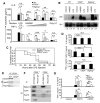CD24 and Siglec-10 selectively repress tissue damage-induced immune responses
- PMID: 19264983
- PMCID: PMC2765686
- DOI: 10.1126/science.1168988
CD24 and Siglec-10 selectively repress tissue damage-induced immune responses
Abstract
Patten recognition receptors, which recognize pathogens or components of injured cells (danger), trigger activation of the innate immune system. Whether and how the host distinguishes between danger- versus pathogen-associated molecular patterns remains unresolved. We report that CD24-deficient mice exhibit increased susceptibility to danger- but not pathogen-associated molecular patterns. CD24 associates with high mobility group box 1, heat shock protein 70, and heat shock protein 90; negatively regulates their stimulatory activity; and inhibits nuclear factor kappaB (NF-kappaB) activation. This occurs at least in part through CD24 association with Siglec-10 in humans or Siglec-G in mice. Our results reveal that the CD24-Siglec G pathway protects the host against a lethal response to pathological cell death and discriminates danger- versus pathogen-associated molecular patterns.
Figures




Comment in
-
Immunology. Dangers in and out.Science. 2009 Mar 27;323(5922):1683-4. doi: 10.1126/science.1172794. Science. 2009. PMID: 19325105 No abstract available.
References
-
- Janeway CA. Cold Spring Harbor Symposia on Quantitative Biology. 1989;54:1. - PubMed
-
- Liu Y, Janeway CA., Jr. International Immunology. 1991;3:323. - PubMed
-
- Medzhitov R, Preston-Hurlburt P, Janeway CA., Jr. Nature. 1997 Jul 24;388:394. - PubMed
-
- Matzinger P. Annual Review of Immunology. 1994;12:991. - PubMed
Publication types
MeSH terms
Substances
Grants and funding
LinkOut - more resources
Full Text Sources
Other Literature Sources
Medical
Molecular Biology Databases

